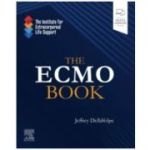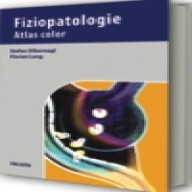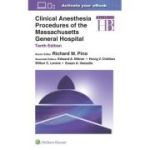Intensive Care, A Concise Textbook

Preț: 315,00 lei
Disponibilitate: nu mai face parte din ofertă
ISBN: 978-0-7020-2596-9
Editura: Saunders
Anul publicarii: 2008
Ediția: 3
Pagini: 600
Categoria: CRITICAL CARE
DESCRIERE
Now in its third edition, 'Intensive Care: A Concise Textbook' continues to provide an excellent introductory text to the practice of critical care medicine. Extensively revised, expanded and updated, the format of the new edition has been radically altered to make the text more readable and the information even more accessible. Comprehensive yet concise, the book provides a sound working knowledge of the discipline, is packed with information and is extensively referenced. Current evidence based guidelines for managing critically ill patients with complex pathophysiology and multisystem involvement are highlighted throughout. The book is intended primarily for trainees in intensive care medicine and has been designed particularly to meet the requirements of those preparing for examinations in this specialty (specifically European, UK and Irish Diplomas of Intensive Care). It is aimed not only at those embarking on specialist training in intensive care but also at trainees in other acute specialities who are increasingly becoming involved in the management of critically ill patients, and who may be sitting other postgraduate exams that include intensive care and acute medicine in the syllabus (e. g. FRCA, MRCS, MRCP). The book will also serve as a valuable reference text for both trainees and qualified specialists.
Key Features
* Provides a balanced view of current controversies with citation of the most relevant publications
* Information readily accessible through the extensive use of bullet points, italics to highlight key words, headings, sub-headings, tables, figures and diagrams
* Written entirely by two authors to ensure consistency of style and content, each chapter has been reviewed by an expert to ensure completion, accuracy and currency
* Ideal for physicians preparing for the increasingly important examinations in the specialty
* Includes summary tables of recommended approaches to clinical management
* Also suitable for trainees in other acute specialities who are increasingly becoming involved in the management of critically ill patients and those who may be sitting other postgraduate exams that include aspects of intensive care and acute medicine in the syllabus
New to this Edition
* All content fully updated and strongly evidence-based, with clear guidelines for the management of specific conditions
* Extensive new referencing focuses on key prospective, randomised, controlled trials, meta-analyses and systematic reviews
* Additional topics such as relative adrenal suppression, tight glycaemic control, acute coronary syndromes, ventilator-associated and community-acquired pneumonia, non-invasive and ‘protective’ ventilation, meningo-encephalitis and intracranial haemorrhage
* Updated antibiotic guidelines and the latest ALS/ATLS and ‘surviving sepsis campaign guidelines’
* More detail given to a number of topics such as fluid and electrolyte balance, nutrition, and alternatives to the pulmonary artery catheter for haemodynamic monitoring
Table of Contents
1 PLANNING, ORGANIZATION AND MANAGEMENT:
Introduction; Levels of care and facilities required to deliver a critical care service; Designing critical care areas; Management of the critical care service
2 OUTCOME AND COSTS:
Mortality, long-term survival and quality of life; End-of-life decision-making, withholding and withdrawing treatment; Severity scoring systems
3 APPLIED CARDIOVASCULAR AND RESPIRATORY PHYSIOLOGY:
Oxygen delivery; Cardiac output; Oxygen content; Pulmonary ventilation and gas exchange; Mixed venous oxygen tension; Lung volumes; Lung mechanics and work of breathing; Control of breathing
4 ASSESSMENT AND MONITORING OF CARDIOVASCULAR FUNCTION:
Heart rate; Blood pressure; Pre-load; Cardiac output and myocardial function
5 SHOCK, SEPSIS AND MULTIPLE ORGAN FAILURE:
Definition; Causes; Pathophysiology; Clinical features of shock; Monitoring and laboratory investigations in shock; Management; Multiple organ failure; Adjunctive therapy in shock, sepsis and organ failure; Anaphylactic shock; Pulmonary embolism
6 ASSESSMENT AND MONITORING OF RESPIRATORY FUNCTION:
Measurement of lung volumes; Assessing airways obstruction; Maximum mouth pressures; Flow-volume and pressure-volume loops; Measuring the work of breathing; Non-invasive monitoring of ventilation; Monitoring inspired and expired gas composition; Measurement of respiratory gas exchange; Blood gas analysis and acid-base disturbances; Determination of oxygen content; In vivo blood gas measurement; Other indices of pulmonary oxygen transfer and lung function
7 RESPIRATORY SUPPORT:
Negative pressure ventilation; Positive pressure ventilation; Beneficial effects of mechanical ventilation; Indications for mechanical ventilation; Dangers of mechanical ventilation; Institution of invasive respiratory support; Management of patients on ventilators; Tracheal intubation; Tracheostomy
8 RESPIRATORY FAILURE:
Definition; Types, mechanisms and clinical features; Causes of respiratory failure; Principles of management; Some common causes of respiratory failure in the intensive care unit
9 MYOCARDIAL ISCHAEMIA, CARDIOPULMONARY RESUSCITATION AND MANAGEMENT OF ARRHYTHMIAS:
Acute coronary syndromes; Cardiorespiratory arrest; Postresuscitation management; Cardiorespiratory arrest associated with special circumstances; Prognosis of cardiorespiratory arrest; Management of arrhythmias
10 TRAUMA:
Advanced trauma life support and trauma resuscitation; Chest injuries; Burns; Spinal injuries; Near drowning; Fat embolism syndrome; Crush injuries
11 GENERAL ASPECTS OF MANAGING CRITICALLY ILL PATIENTS:
Fluid and electrolyte balance; Nutritional support; Sedation, analgesia and muscle relaxation; Prevention of deep venous thrombosis and pulmonary thromboembolism; Prevention of stress ulceration; Psychological and behavioural disorders
12 INFECTION IN THE CRITICALLY ILL:
Factors predisposing to infection in hospitalized patients; Sources and prevention of infection; Nosocomial infections in the critically ill; The rational use of antibiotics; Antibiotic-associated diarrhoea; Unusual pathogens-diagnosis and treatment; The immunocompromised patient
13 ACUTE RENAL FAILURE:
Definition, incidence and causes; Pathogenesis and pathophysiology of acute intrinsic renal failure; Diagnosis and investigations; Clinical course and management; Prognosis of ARF
14 ACUTE LIVER FAILURE:
Types of acute liver failure; Causes of liver dysfunction in critical illness; Acute liver failure; Acute decompensation of chronic liver disease
15 NEUROLOGICAL DISORDERS:
Head injuries and raised intracranial pressure; Acute bacterial meningitis; Encephalitis; Non-traumatic intracranial haemorrhage; Brain death and irreversible cerebral damage; Confirmatory tests; Status epilepticus; Tetanus; Myasthenia gravis; Acute inflammatory polyradiculoneuropathy; Critical illness polyneuromyopathy
16 GASTROINTESTINAL DISORDERS:
Gastrointestinal haemorrhage; Abdominal emergencies
17 ENDOCRINE EMERGENCIES:
Diabetes mellitus; Thyroid emergencies; Calcium metabolism; Phaeochromocytoma; Adrenal crisis; Pituitary emergencies
18 OBSTETRIC INTENSIVE CARE:
Physiological alterations in pregnancy; Severity scoring systems in the obstetric population; Pre-eclampsia; Acute lung injury/acute respiratory distress syndrome in obstetric patients; Peripartum cardiomyopathy; Acute coagulopathy in pregnancy
19 POISONING:
Types of poisoning; Diagnosis and assessment; Principles of management; Management of specific poisonings
20 DISTURBANCES OF BODY TEMPERATURE:
Accidental hypothermia; Hyperthermia
21 TRANSPORTING THE CRITICALLY ILL:
Primary transport; Secondary transport; Modes of transport; Equipment for transport; Transport within the hospital; Transport over long distances
APPENDICES:
Normal values.
Key Features
* Provides a balanced view of current controversies with citation of the most relevant publications
* Information readily accessible through the extensive use of bullet points, italics to highlight key words, headings, sub-headings, tables, figures and diagrams
* Written entirely by two authors to ensure consistency of style and content, each chapter has been reviewed by an expert to ensure completion, accuracy and currency
* Ideal for physicians preparing for the increasingly important examinations in the specialty
* Includes summary tables of recommended approaches to clinical management
* Also suitable for trainees in other acute specialities who are increasingly becoming involved in the management of critically ill patients and those who may be sitting other postgraduate exams that include aspects of intensive care and acute medicine in the syllabus
New to this Edition
* All content fully updated and strongly evidence-based, with clear guidelines for the management of specific conditions
* Extensive new referencing focuses on key prospective, randomised, controlled trials, meta-analyses and systematic reviews
* Additional topics such as relative adrenal suppression, tight glycaemic control, acute coronary syndromes, ventilator-associated and community-acquired pneumonia, non-invasive and ‘protective’ ventilation, meningo-encephalitis and intracranial haemorrhage
* Updated antibiotic guidelines and the latest ALS/ATLS and ‘surviving sepsis campaign guidelines’
* More detail given to a number of topics such as fluid and electrolyte balance, nutrition, and alternatives to the pulmonary artery catheter for haemodynamic monitoring
Table of Contents
1 PLANNING, ORGANIZATION AND MANAGEMENT:
Introduction; Levels of care and facilities required to deliver a critical care service; Designing critical care areas; Management of the critical care service
2 OUTCOME AND COSTS:
Mortality, long-term survival and quality of life; End-of-life decision-making, withholding and withdrawing treatment; Severity scoring systems
3 APPLIED CARDIOVASCULAR AND RESPIRATORY PHYSIOLOGY:
Oxygen delivery; Cardiac output; Oxygen content; Pulmonary ventilation and gas exchange; Mixed venous oxygen tension; Lung volumes; Lung mechanics and work of breathing; Control of breathing
4 ASSESSMENT AND MONITORING OF CARDIOVASCULAR FUNCTION:
Heart rate; Blood pressure; Pre-load; Cardiac output and myocardial function
5 SHOCK, SEPSIS AND MULTIPLE ORGAN FAILURE:
Definition; Causes; Pathophysiology; Clinical features of shock; Monitoring and laboratory investigations in shock; Management; Multiple organ failure; Adjunctive therapy in shock, sepsis and organ failure; Anaphylactic shock; Pulmonary embolism
6 ASSESSMENT AND MONITORING OF RESPIRATORY FUNCTION:
Measurement of lung volumes; Assessing airways obstruction; Maximum mouth pressures; Flow-volume and pressure-volume loops; Measuring the work of breathing; Non-invasive monitoring of ventilation; Monitoring inspired and expired gas composition; Measurement of respiratory gas exchange; Blood gas analysis and acid-base disturbances; Determination of oxygen content; In vivo blood gas measurement; Other indices of pulmonary oxygen transfer and lung function
7 RESPIRATORY SUPPORT:
Negative pressure ventilation; Positive pressure ventilation; Beneficial effects of mechanical ventilation; Indications for mechanical ventilation; Dangers of mechanical ventilation; Institution of invasive respiratory support; Management of patients on ventilators; Tracheal intubation; Tracheostomy
8 RESPIRATORY FAILURE:
Definition; Types, mechanisms and clinical features; Causes of respiratory failure; Principles of management; Some common causes of respiratory failure in the intensive care unit
9 MYOCARDIAL ISCHAEMIA, CARDIOPULMONARY RESUSCITATION AND MANAGEMENT OF ARRHYTHMIAS:
Acute coronary syndromes; Cardiorespiratory arrest; Postresuscitation management; Cardiorespiratory arrest associated with special circumstances; Prognosis of cardiorespiratory arrest; Management of arrhythmias
10 TRAUMA:
Advanced trauma life support and trauma resuscitation; Chest injuries; Burns; Spinal injuries; Near drowning; Fat embolism syndrome; Crush injuries
11 GENERAL ASPECTS OF MANAGING CRITICALLY ILL PATIENTS:
Fluid and electrolyte balance; Nutritional support; Sedation, analgesia and muscle relaxation; Prevention of deep venous thrombosis and pulmonary thromboembolism; Prevention of stress ulceration; Psychological and behavioural disorders
12 INFECTION IN THE CRITICALLY ILL:
Factors predisposing to infection in hospitalized patients; Sources and prevention of infection; Nosocomial infections in the critically ill; The rational use of antibiotics; Antibiotic-associated diarrhoea; Unusual pathogens-diagnosis and treatment; The immunocompromised patient
13 ACUTE RENAL FAILURE:
Definition, incidence and causes; Pathogenesis and pathophysiology of acute intrinsic renal failure; Diagnosis and investigations; Clinical course and management; Prognosis of ARF
14 ACUTE LIVER FAILURE:
Types of acute liver failure; Causes of liver dysfunction in critical illness; Acute liver failure; Acute decompensation of chronic liver disease
15 NEUROLOGICAL DISORDERS:
Head injuries and raised intracranial pressure; Acute bacterial meningitis; Encephalitis; Non-traumatic intracranial haemorrhage; Brain death and irreversible cerebral damage; Confirmatory tests; Status epilepticus; Tetanus; Myasthenia gravis; Acute inflammatory polyradiculoneuropathy; Critical illness polyneuromyopathy
16 GASTROINTESTINAL DISORDERS:
Gastrointestinal haemorrhage; Abdominal emergencies
17 ENDOCRINE EMERGENCIES:
Diabetes mellitus; Thyroid emergencies; Calcium metabolism; Phaeochromocytoma; Adrenal crisis; Pituitary emergencies
18 OBSTETRIC INTENSIVE CARE:
Physiological alterations in pregnancy; Severity scoring systems in the obstetric population; Pre-eclampsia; Acute lung injury/acute respiratory distress syndrome in obstetric patients; Peripartum cardiomyopathy; Acute coagulopathy in pregnancy
19 POISONING:
Types of poisoning; Diagnosis and assessment; Principles of management; Management of specific poisonings
20 DISTURBANCES OF BODY TEMPERATURE:
Accidental hypothermia; Hyperthermia
21 TRANSPORTING THE CRITICALLY ILL:
Primary transport; Secondary transport; Modes of transport; Equipment for transport; Transport within the hospital; Transport over long distances
APPENDICES:
Normal values.
Categorii de carte
-Comandă specială
-Edituri
-Promo
-Publicaţii Callisto
-Cărţi noi
-- 567,00 lei
- 430,50 leiPRP: 472,50 lei
- 399,00 lei
Promoţii
-- 430,50 leiPRP: 472,50 lei
- 529,20 leiPRP: 588,00 lei
- 315,00 leiPRP: 367,50 lei











REVIEW-URI